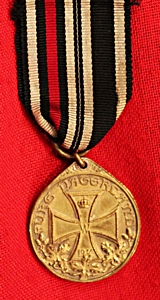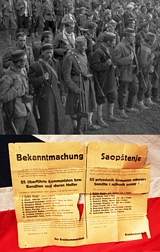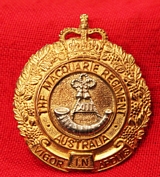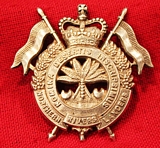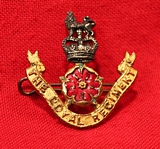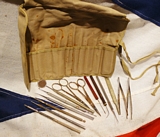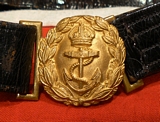WW1 / WW2 / 20th Century
German WW1 Medal of the German Legion of Honour.
Deutsche Ehrendenkm?nze des Weltkrieges der Deutschen Ehrenlegion.
Awarded by the "Council of the Order" of the Union of Nationalist Soldiers to men or women who, during WWI and after dutifully served the Fatherland.
This bronze medal, either gilded or coppered. Noteworthy is the portayal of the winged Victory crowning a German soldier on the obverse. The reverse shows the Iron Cross 1st Class with oak leaves around the lower rim of the medal. Along the upper edge of the medal is the text "F?RS VATERLAND" (For the Fatherland) in Gothic lettering. The ribbon is formed with the then German national colours.
For frontline troops a combat emblem was created for attachment to the ribbon : a gilt oak leaf wreath with a sword across.
This medal was first proposed in the autumn of 1917 but it took till 1921 before the "Council of the Order", which was to effect the actual awarding, was formed. Recipients had to pay for their medal themselves and could, if they so wished, be entered in the German Legion of Honour. This organization was divided in "Ritterschaften" (knight groups) and its members could call themselves "Ritter der Deutschen Ehrenlegion" (Knight of the German Legion of Honour).
Early in the Nazi era, by a decree of 15 May 1934, awards like these were forbidden and the German Legion of Honour joined the Kyffh?user-Bund (the official veterans' organization) soon after. read more
75.00 GBP
A Nazi German Occupation WW2 Public Notice Wanted Poster 1944
Listing in two languages, German and East European [possibly Slovenian] 55 Communist Bandits and their helpers. Various torn areas but vital to be kept as a piece of unique WW2 history. Would be perfect framed for display. In the aftermath of Munich, Slovak politicians from the democratic parties (Republican Party of Farmers and Peasants, Czechoslovak Social Democratic Party, and Czechoslovak National Socialist Party) organized a resistance movement. Individual underground cells sprang up in towns and villages throughout Slovakia. A campaign of "whispering" propaganda was initiated to alert the acquiescent Slovak population to the true nature of the Tiso regime. The goal of the democratic resistance was the restoration of the Czechoslovak Republic, but with greater participation for Slovakia. In the spring of 1939, the "Zeta" headquarters was established in Bratislava to coordinate with the Czech resistance and to transmit intelligence information to the liberation movement abroad. Party Communists remaining in Slovakia formed the underground Communist of Slovakia (Komunisticka strana Slovenska--KSS) and until 1943 favored the creation of an independent "Soviet Slovakia."
The shortage of qualified personnel enabled resistance members to infiltrate all levels of the Tiso administration, where they promoted economic sabotage. Mutiny within the Slovak army (marshaled by the Axis powers for combat against Poland and, later, the Soviet Union) was encouraged and became commonplace. At Kremnica, on September 15, 1939, approximately 3,500 Slovak soldiers abandoned their transport train and marched into the city. Members of the underground Slovak Revolutionary Youth set fire to machinery in factories, emptied the fuel tanks of locomotives, and exploded munitions in warehouses. Slovak youth turned increasingly against the Tiso regime.
In his Christmas broadcast of 1942, Benes called for resistance groups in Slovakia to increase their activity in preparation for a seizure of power. The groups worked to unify their efforts. The following November, negotiations between democratic and communist resistance leaders culminated in the signing of the Christmas Agreement of 1943. The agreement called for the creation of the Slovak National Council to represent the political will of the Slovak nation. The Slovak National Council would act in concert with the Czechoslovak government and liberation movement abroad. The postwar Czechoslovak state would be democratic and organized on the basis of national equality. The Christmas Agreement provided also for a close association with the Soviet Union in foreign policy and military affairs. Benes endorsed the agreement on March 27, 1944.
The Allied powers agreed that Slovakia would be liberated by Soviet armies. In March 1944, with Benes's approval, the Slovak National Council authorized Lieutenant-Colonel Jan Golian to prepare for a national coup to be coordinated with the arrival of Soviet troops. Golian organized a secret military center at Banska Bystrica and created Slovak partisan units composed of escaped prisoners of war and army deserters. The Slovak National Uprising of August 29, however, was premature. The Soviet government, regarding the Slovak resistance as politically suspect, failed to inform the Slovaks of a change in Soviet strategy. Despite American efforts to assist the uprising, the German Wehrmacht occupied Slovakia, and Banska Bystrica fell on October 27. Nonetheless, local partisan warfare continued up to the liberation. read more
120.00 GBP
13th Battalion (The Macquarie Regiment) - Bi Metal Hat Badge 1953 - 60
13th Battalion (The Macquarie Regiment) - Bi Metal Hat Badge 1953 - 60. Complete with two lugs. The 13th Battalion was an infantry battalion of the Australian Army. Originally raised for the 1st Australian Imperial Force during the First World War, it was formed just six weeks after the start of the war. Along with the 14th, 15th and 16th Battalions which were recruited from New South Wales, it formed the 4th Brigade. The battalion saw service initially at Gallipoli before being transferred to France in 1916. For the next two years it fought in the trenches of the Western Front, earning numerous battle honours in the process.
Following the end of the war, the 13th Battalion was demobilised in early 1919. It was re-raised in 1921 as a unit of the part-time Citizens Force, based around Maitland, New South Wales. During the Second World War the battalion undertook garrison duties before being amalgamated with the 33rd Battalion in October 1942. It was re-raised for a third and final time sometime after 1948 and remained on the order of battle until 1960 when it was subsumed into the Royal New South Wales Regiment. read more
90.00 GBP
Northern River Lancers - White Metal Hat Badge 1953 - 56
The 15th Northern River Lancers was an amphibious assault squadron of the Australian Army, the Lancers were designated 'A' Squadron, Amphibious Assault Regiment. The 15th Northern River Lancers were formed in 1948 and based in Northern New South Wales, in 1956 it was amalgamated with the 1st Royal New South Wales Lancers to become 1st/15th Royal New South Wales Lancers. read more
110.00 GBP
A Very Good Officer's Silver and Gilt Cap Badge of the Loyal Regt. the Lancashire 1950's.
Original early ERII. With red rose centre and gilt regimental banner. Silver crowned lion. 2 part construction. At the outbreak of World War II, the 1st Battalion Loyals were part of the 2nd Infantry Brigade, attached to the 1st Infantry Division. In September 1939 they were sent to France as part of the British Expeditionary Force and remained there alongside the French Army until May 1940. The 1st Loyals would participate in the fighting in France and Belgium in 1940, including acting as part of the rearguard for the Dunkirk evacuation. Eventually, the 1st Loyals would see action in Tunisia in early 1943, and Italy and at the Battle of Anzio where the 1st Division saw some of the fiercest fighting of the war. The battalion along with the rest of 1st Division were sent to Palestine in 1945. During the fighting in the Tunisian campaign, in April 1943, Lieutenant Willward Alexander Sandys-Clarke was posthumously awarded the regiment's only Victoria Cross of the war for his extreme heroism.
Upon the commencement of hostilities in 1939, the 2nd Battalion, Loyal Regiment found themselves stationed in the Far East as part of Singapore Fortress's 1st Malaya Infantry Brigade. After the Japanese attack on Pearl Harbor, the 2nd Loyals fought in Malaya as part of the delaying action during the Battle of Malaya. Eventually, the 2nd Battalion surrendered along with the rest of the Singapore garrison on 15 February 1942. The survivors spent the rest of the war as prisoners of the Imperial Japanese Army.
Following the destruction of the 2nd Loyals with its surrender at Singapore, the battalion was reformed in Britain. The 10th Battalion, a hostilities-only battalion raised in 1940, was re-designated as the new 2nd Battalion on 28 May 1942. Eventually the battalion was deployed as part of 20th Indian Infantry Brigade of the 10th Indian Infantry Division in Italy during the closing phases of the Italian Campaign read more
55.00 GBP
WW2 Period Chinese Bank of Communications 25-Yuan Note,
1941, serial no. 784417 green, electric direct
current generator, Zeppelin and plane at centre. Established in 1908, Bank of Communication claims a long history in China and is one of the banks to have issued banknotes in modern Chinese history. read more
45.00 GBP
An Original Desk Paperknife Made From Duralumin Of Airship USS Akron
Made from Duralumin taken from the construction of the airship. USS Akron (ZRS-4) was a helium-filled rigid airship of the U.S. Navy that was destroyed in a thunderstorm off the coast of New Jersey on the morning of 4 April 1933, killing 73 of her 76 crewmen and passengers. This accident was the largest loss of life for any known airship crash. During her accident-prone 18-month term of service, the Akron also served as a flying aircraft carrier for launching and recovering F9C Sparrowhawk fighter planes.
With lengths of 785 ft (239 m), 20 ft (6.1 m) shorter than the German commercial airship Hindenburg, Akron and her sister airship the Macon were among the largest flying objects in the world. Although the Hindenburg was longer, she was filled with hydrogen, so the two U.S. airships still hold the world record for helium-filled airships. read more
145.00 GBP
A WW2 Dental Instruments Medics Kit Roll
Very nice quality instruments that could likely work well today [after polishing and sterilising. read more
60.00 GBP
Operation of Regulations of Zeppelin Airship Construction in Freidrichafen
Published for the Zeppelin Co. in 10th Sept 1934. A paragraph withing the text makes a reference to the SA and SS but sadly as it is printed Gothic German it's devil to translate. The booklet contains operating istructions of the company including such details of working hours, winter and summer, and all manner of expected functions of the staff of the company. Not many of these documents survived. Dr Eckner is named on the last page as the company Fuhrer. The company that ran the Graf Zeppelin and Hindenberg transatlantic airships was the Nazi propaganda based company, titled the DZR, the Deutsche Zeppelin-Reederei. The DZR was created at the instigation of Air Minister Hermann G?ring as a way to increase Nazi control over zeppelin operations, and can be see as part of the larger policy of Gleichschaltung, or coordination, which affected all aspects of German life in the years following Hitler?s assumption of power.
Consistent with Nazi ideology, the airship was expected to be more than just a private commercial venture; it was to be a public symbol of the new German nation. In a speech marking the founding of the DZR, G?ring commented: ?I hope that the new ship will also fulfill its duty in furthering the cause of Germany? The airship does not have the exclusive purpose of flying across the Atlantic, but also has a responsibility to act as the nation?s representative.? read more
135.00 GBP
A WW1 Royal Naval Officer's Belt
Gilt bronze buckle with patent leather belt, however the belt is pretty worn and very small size. read more
85.00 GBP


